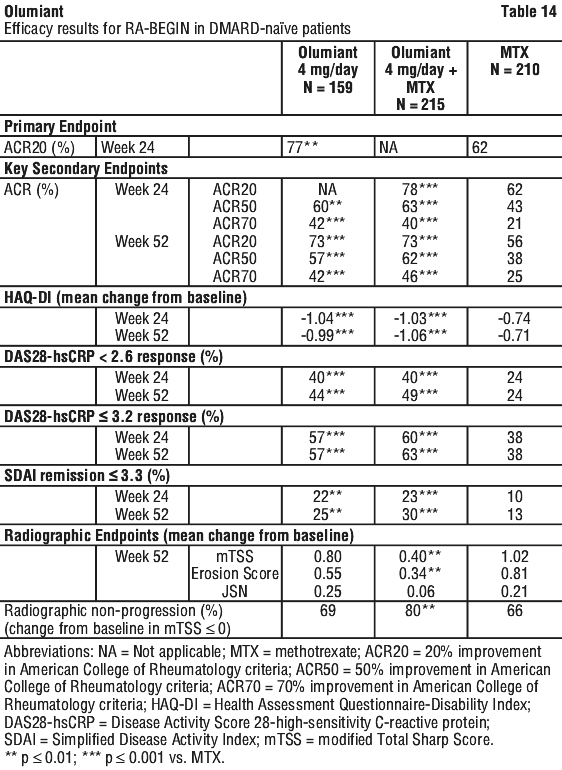SUMMARY CMI
OLUMIANT®
Consumer Medicine Information (CMI) summary
The full CMI on the next page has more details. If you are worried about using this medicine, speak to your doctor or pharmacist.
▼ This medicine is new or being used differently. Please report side effects. See the full CMI for further details.
WARNING: Important safety information is provided in a boxed warning in the full CMI. Read before using this medicine.
1. Why am I taking OLUMIANT?
OLUMIANT contains the active ingredient baricitinib. OLUMIANT is used in adults as a treatment for moderate to severe rheumatoid arthritis, atopic dermatitis (also known as atopic eczema) and severe alopecia areata (a condition resulting in hair loss). For more information, see Section 1. Why am I taking OLUMIANT? in the full CMI.
2. What should I know before I take OLUMIANT?
Do not take OLUMIANT if you have ever had an allergic reaction to baricitinib or any of the ingredients listed at the end of the CMI.Talk to your doctor if you have any other medical conditions, take any other medicines, or are pregnant or plan to become pregnant or are breastfeeding.
For more information, see Section 2. What should I know before I take OLUMIANT? in the full CMI.
3. What if I am taking other medicines?
Some medicines may interfere with OLUMIANT and affect how it works. A list of these medicines is in Section 3. What if I am taking other medicines? in the full CMI.
4. How do I take OLUMIANT?
Follow all directions given to you by your doctor or pharmacist carefully.
The recommended dose will be either 2 mg or 4 mg once a day, depending on factors such as: what you are using OLUMIANT for, how your condition is being controlled, your age, and what other medical conditions you may have.
More instructions can be found in Section 4. How do I take OLUMIANT? in the full CMI.
5. What should I know while taking OLUMIANT?
| Things you should do |
|
| Things you should not do |
|
| Driving or using machines |
|
| Looking after your medicine |
|
For more information, see Section 5. What should I know while taking OLUMIANT? in the full CMI.
6. Are there any side effects?
Potential side effects include a cold, sore throat, runny or blocked nose; cough; nausea, abdominal pain; cold sore blisters; acne; rash; headache. Serious potential side effects include signs of more serious infection; signs of blood clots in the blood vessels of the legs (deep vein thrombosis) or lungs (pulmonary embolism) such as painful swollen legs, chest pain or shortness of breath; signs of diverticulitis (inflammation in parts of the large intestine) such as stomach ache, change in bowel habits, nausea or vomiting, fever; signs of an allergic reaction such as shortness of breath, wheezing or difficulty breathing, swelling of the face, lips, tongue or other parts of the body, severe rash, itching or hives.
For more information, including what to do if you have any side effects, see Section 6. Are there any side effects? in the full CMI.
▼ This medicine is subject to additional monitoring. This will allow quick identification of new safety information. You can help by reporting any side effects you may get. You can report side effects to your doctor, or directly at www.tga.gov.au/reporting-problems.
WARNING:
If you:
• have a history of heart disease or stroke, or other cardiovascular risk factors such as being a current or past long-term smoker; or
• have cancer or have a history of cancer; or
• are 65 years of age and older
OLUMIANT should only be used if no suitable treatment alternatives are available.
FULL CMI
OLUMIANT®
Active ingredient: baricitinib
Consumer Medicine Information (CMI)
This leaflet provides important information about taking OLUMIANT. You should also speak to your doctor or pharmacist if you would like further information or if you have any concerns or questions about using OLUMIANT.
Where to find information in this leaflet:
1. Why am I taking OLUMIANT?
2. What should I know before I take OLUMIANT?
3. What if I am taking other medicines?
4. How do I take OLUMIANT?
5. What should I know while taking OLUMIANT?
6. Are there any side effects?
7. Product details
1. Why am I taking OLUMIANT?
OLUMIANT contains the active ingredient baricitinib. It belongs to a group of medicines called Janus Kinase (JAK) inhibitors. It works by reducing the activity of the enzyme Janus Kinase, which is involved in inflammation.
OLUMIANT is used in adults as a treatment for moderate to severe:
- rheumatoid arthritis
- atopic dermatitis, also known as atopic eczema.
OLUMIANT is used in adults as a treatment for severe:
- alopecia areata.
Rheumatoid arthritis is an autoimmune disease which means the body's immune system mistakenly attacks its own tissues. Symptoms include joint pain, tenderness, swelling and stiffness.
Atopic dermatitis is a chronic skin condition marked by intense itching, inflammation and dryness of the skin. OLUMIANT helps improve the condition of your skin inflammation and reduce associated itching.
Alopecia areata is an autoimmune disorder that results in hair loss, most often affecting the scalp but can occur on any hair-bearing skin. OLUMIANT helps regrowth of hair on the scalp, eyebrows and eyelashes.
OLUMIANT can be used alone or with other medicines used to treat rheumatoid arthritis or with eczema medicines that you apply to the skin.
2. What should I know before I take OLUMIANT?
Warnings
Do not take OLUMIANT if:
- you are allergic to baricitinib, or any of the ingredients listed at the end of this leaflet. Always check the ingredients to make sure you can use this medicine
- you are taking any biological (injectable) treatment for your condition.
Tell your doctor if you:
- have allergies to any other medicines, foods, preservatives or dyes
- are 65 years of age and older
- are a current or past long-term smoker
- have recently undergone, or will soon undergo, major surgery
- are restricted in movement due to an injury
- have a family history of blood clotting disorders
- have or ever had any other medical conditions such as:
- infection: if you are being treated for an infection, have a lot of infections or have infections that keep coming back
- tuberculosis or have been in contact with someone who has tuberculosis
- diabetes
- hepatitis B or C
- shingles
- low white or red blood cells
- kidney problems
- high cholesterol
- liver problems
- cancer
- blood clots in the blood vessels of your legs (deep vein thrombosis), arms or lungs (pulmonary embolism) or clots in the arteries in the past
- chest pain or any heart problem
- diverticulitis (inflammation in parts of the large intestine) - recently been vaccinated or plan to get vaccinated
- take oral contraceptives ('the pill') or hormone replacement therapy
- take any medicines for any other condition.
An increased risk of death has been seen in patients with rheumatoid arthritis patients who took a similar medicine to OLUMIANT. These patients were 50 years of age with risk factors for heart disease.
During treatment, you may be at risk of developing certain side effects. It is important you understand these risks and how to monitor for them. See additional information under Section 6. Are there any side effects?
Pregnancy and breastfeeding
Tell your doctor if you are pregnant or intend to become pregnant.
- It is not known if OLUMIANT will harm your unborn baby.
- You should use an effective method of contraception to avoid becoming pregnant while taking OLUMIANT and for at least one week after your final dose. Your doctor can discuss the risks and benefits involved.
Talk to your doctor if you are breastfeeding or intend to breastfeed.
- It is not known if OLUMIANT passes into your breastmilk. You should not breastfeed if you are taking OLUMIANT.
Use in children
- OLUMIANT is not intended for use by children under the age of 18 years.
Use in the elderly
An increased risk of getting certain side effects, including heart attacks, stroke, cancer, and infections (some of which may be serious), has been seen in patients with rheumatoid arthritis patients who took a similar medicine to OLUMIANT. These side effects were more common in patients 65 years of age and older.
Shingles (herpes zoster virus)
Tell your doctor if you have ever had shingles. OLUMIANT can reactivate shingles in people who have had shingles in the past.
Hepatitis B virus (HBV) or hepatitis C virus (HCV)
Tell your doctor if you are a carrier of the hepatitis B virus (HBV) or hepatitis C virus (HCV), or if you have hepatitis B or hepatitis C infection. If you have HBV or HCV in your blood, it may become active while you are taking OLUMIANT. This effect has been reported with other medicines used to treat rheumatoid arthritis.
Vaccination
- Make sure you are up to date with all vaccinations before starting OLUMIANT.
- Tell your doctor if you are scheduled for any vaccines or have recently been vaccinated. Some vaccines should not be given while you are taking OLUMIANT. Check with your doctor before receiving any vaccines.
3. What if I am taking other medicines?
Tell your doctor or pharmacist if you are taking any other medicines, including any medicines, vitamins or supplements that you buy without a prescription from your pharmacy, supermarket or health food shop.
Some medicines may interfere with OLUMIANT and affect how it works.
These include medications used to treat gout such as probenecid that may increase the levels of OLUMIANT in your blood.
Some medicines, when taken with OLUMIANT, may make you more prone to experiencing side effects.
These include oral contraceptives ('the pill') and hormone replacement therapy, which may increase your risk of developing blood clots.
Tell your doctor if you are taking medicines for diabetes. Your doctor may adjust the dose of your diabetic medication while you are taking OLUMIANT.
Check with your doctor or pharmacist if you are not sure about what medicines, vitamins or supplements you are taking and if these affect OLUMIANT.
4. How do I take OLUMIANT?
How much to take
Your doctor will tell you how much you need to take each day.
OLUMIANT is supplied as 4 mg and 2 mg tablets.
- The recommended dose for rheumatoid arthritis is one 4 mg tablet taken once a day. Your doctor may reduce your dose once your condition is under control.
- The recommended dose for atopic dermatitis is 2 mg once a day. Your doctor may increase your dose to 4 mg once a day if you have not achieved sustained control of your condition with 2 mg and then may reduce to 2 mg once a day once you have achieved sustained control of you condition with 4 mg once a day.
- The recommended dose for alopecia areata is one 4 mg tablet taken once a day. Your doctor may start your dose at one 2 mg tablet once a day especially if you are at a higher risk of heart disease, stroke, blood clots or cancer, are 65 years of age and older, or have a history of recurring infections. The doctor may adjust your dose depending on how your condition is being controlled.
Your doctor may also adjust your dose depending on your condition, for example if you have a kidney problem, or are taking medication to treat gout.
Continue taking your medicine for as long as your doctor tells you. This medicine helps to control your condition. It is important to keep taking your medicine even if you feel well.
Follow all directions given to you by your doctor or pharmacist carefully.
When to take OLUMIANT
- Take OLUMIANT tablets at about the same time every day. Taking it at the same time every day will help you remember when to take it.
- OLUMIANT can be taken with or without food.
How to take OLUMIANT
- Swallow the tablet whole with a glass of water.
If you forget to take OLUMIANT
If it is almost time for your next dose, skip the dose you missed and take your next dose when you are meant to.
Otherwise, take it as soon as you remember, and then go back to taking your medicine as you would normally.
Do not take a double dose to make up for the dose you missed.
If you take too much OLUMIANT
If you think that you have taken too much OLUMIANT, you may need urgent medical attention.
You should immediately:
- phone the Poisons Information Centre
(by calling 13 11 26), or - contact your doctor, or
- go to the Emergency Department at your nearest hospital.
You should do this even if there are no signs of discomfort or poisoning.
5. What should I know while taking OLUMIANT?
Things you should do
Tell your doctor if you experience signs and symptoms of infection such as:
- fever, sweating or chills
- muscle aches
- cough
- shortness of breath
- weight loss
- warm, red or painful skin or sores on your body
- burning when you urinate or urinating more often than normal
- feeling very tired.
OLUMIANT may lower the ability of your body to fight infections, especially in patients 65 years of age and older.
Tell your doctor if you get a painful swollen leg, chest pain, or shortness of breath as these can be signs of blood clots.
Blood clots in the blood vessels of the legs (deep vein thrombosis) or lungs (pulmonary embolism) have been reported in patients taking OLUMIANT.
Tell your doctor if you develop chest pain and sudden changes to your vision or speech. You may be at greater risk of heart attack or stroke while taking OLUMIANT.
You may be at greater risk of certain cancers, such as non-melanoma skin cancer, while taking OLUMIANT.
Schedule regular skin examinations with your doctor.
Keep all of your appointments with your doctors so that your progress can be checked.
Your doctors will perform blood tests at regular intervals during your treatment to monitor your blood cells, liver enzymes and cholesterol.
Call your doctor straight away if you:
- become pregnant while taking this medicine.
You should use an effective method of contraception to avoid becoming pregnant while taking OLUMIANT and for at least one week after your final dose.
Remind any doctor, dentist or pharmacist you visit that you are taking OLUMIANT.
Things you should not do
- Do not take OLUMIANT to treat any other conditions unless your doctor tells you to.
- Do not give your medicine to anyone else, even if they have the same condition as you.
- Do not stop taking your medicine, or change the dosage, without checking with your doctor.
Driving or using machines
Be careful before you drive or use any machines or tools until you know how OLUMIANT affects you.
Looking after your medicine
- Keep your tablets in the original pack until it is time to take them.
- Store below 30°C.
Store it in a cool dry place away from moisture, heat or sunlight; for example, do not store it:
- in the bathroom or near a sink, or
- in the car or on window sills.
Keep it where young children cannot reach it.
When to discard your medicine
Do not take this medicine if the packaging is torn or of the seals over the carton ends are missing or broken.
If it is damaged, return it to your pharmacist for safe disposal.
Getting rid of any unwanted medicine
If you no longer need to use this medicine or it is out of date, take it to any pharmacy for safe disposal.
Do not use this medicine after the expiry date.
6. Are there any side effects?
All medicines can have side effects. If you do experience any side effects, most of them are minor and temporary. However, some side effects may need medical attention.
See the information below and, if you need to, ask your doctor or pharmacist if you have any further questions about side effects.
Less serious side effects
| Less serious side effects | What to do |
Signs of an infection, such as:
| Speak to your doctor if you have any of these less serious side effects and they worry you. |
Serious side effects
| Serious side effects | What to do |
Signs of a possible serious infection, such as:
| Tell your doctor if you have any of these serious side effects as they may require medical attention. |
Signs of an allergic reaction:
| Call your doctor straight away or go straight to the Emergency Department at your nearest hospital if you notice any of these serious side effects. |
Tell your doctor or pharmacist if you notice anything else that may be making you feel unwell.
Some side effects (for example changes in cholesterol, liver or other enzymes, and blood cells levels) can only be found when your doctor does tests from time to time to check your progress.
Other side effects not listed here may occur in some people.
Reporting side effects
After you have received medical advice for any side effects you experience, you can report side effects to the Therapeutic Goods Administration online at www.tga.gov.au/reporting-problems. By reporting side effects, you can help provide more information on the safety of this medicine.
Always make sure you speak to your doctor or pharmacist before you decide to stop taking any of your medicines.
7. Product details
This medicine is only available with a doctor's prescription.
What OLUMIANT contains
| Active ingredient (main ingredient) | baricitinib |
| Other ingredients (inactive ingredients) | croscarmellose sodium magnesium stearate mannitol microcrystalline cellulose iron oxide red lecithin macrogol 3350 polyvinyl alcohol purified talc titanium dioxide |
Do not take this medicine if you are allergic to any of these ingredients.
This medicine does not contain sucrose, gluten, tartrazine or any other azo dyes.
What OLUMIANT looks like
OLUMIANT 4 mg tablets are pink, round, film-coated tablets, marked with "Lilly" on one side and "4" on the other side (Aust R 277917).

OLUMIANT 2 mg tablets are pale pink, oblong, film-coated tablets, marked with "Lilly" on one side and "2" on the other side (Aust R 277905).

Both tablets contain a dent on each face of the tablet to help you with picking them up.
Who distributes OLUMIANT
Eli Lilly Australia Pty Ltd
Level 9, 60 Margaret Street
Sydney, NSW 2000
AUSTRALIA
® = Registered Trademark
If you have any questions about OLUMIANT, contact Eli Lilly at 1800 454 559 (Australia) or your healthcare professional for assistance.
This leaflet was prepared in March 2025
VA6.0
Published by MIMS April 2025

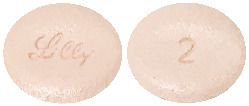
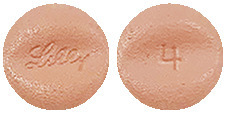




 In patients treated with any dose of baricitinib, adverse events that occurred in fewer than 1% of patients include myocardial infarction and B cell lymphoma.
In patients treated with any dose of baricitinib, adverse events that occurred in fewer than 1% of patients include myocardial infarction and B cell lymphoma.
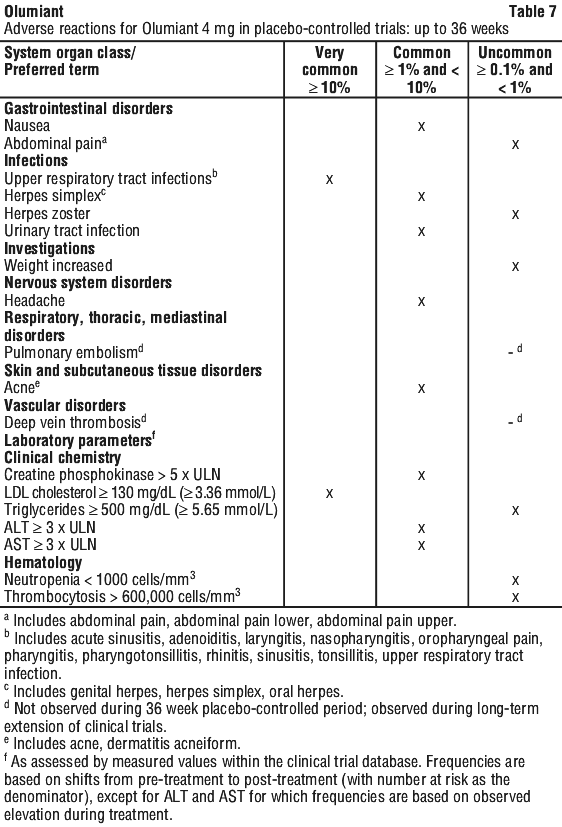






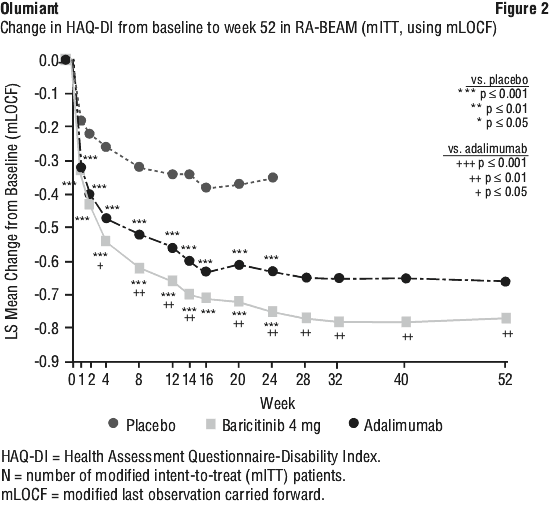 Treatment with Olumiant 4 mg, alone or in combination with cDMARDs, resulted in a significant improvement in pain compared to all comparators (placebo, MTX, and adalimumab), as measured on a 0-100 visual analogue scale, at 12 weeks. Greater pain reduction was seen as early as Week 1 and, in RA-BEGIN and RA-BEAM, this was maintained for up to 52 weeks.
Treatment with Olumiant 4 mg, alone or in combination with cDMARDs, resulted in a significant improvement in pain compared to all comparators (placebo, MTX, and adalimumab), as measured on a 0-100 visual analogue scale, at 12 weeks. Greater pain reduction was seen as early as Week 1 and, in RA-BEGIN and RA-BEAM, this was maintained for up to 52 weeks.
